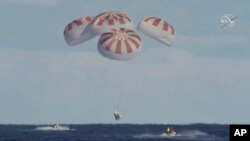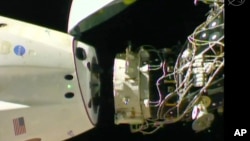An American spacecraft designed to carry astronauts has successfully completed a six-day test mission.
The unmanned SpaceX Crew Dragon capsule touched down safely Friday morning in the Atlantic Ocean. The landing happened about 300 kilometers off the coast of Florida.
Crew Dragon began its six-hour trip back to Earth after pulling away from the International Space Station, or ISS. The spacecraft spent the week docked at the ISS. Crew Dragon launched on March 2 from Florida’s Kennedy Space Center. It successfully linked up with the space station the next day.
SpaceX employees who watched the landing at company headquarters in California cheered when the red and white parachutes opened to lower Crew Dragon into the water.
“I'm kind of shaky and I'm super excited,” said Benji Reed, SpaceX's director of crew mission management. “Everything happened just perfectly, right on time the way that we expected it to.”
It was the first time in 50 years that a capsule designed for astronauts returned from space by landing in the Atlantic Ocean. The last time was on March 13, 1969, when America’s Apollo 9 landed in the ocean after orbiting Earth in preparation for moon landings.
American space station astronauts have been carried to space by Russian rockets since the U.S. space agency NASA halted its shuttle program eight years ago.
The successful test mission marked an important moment for the U.S. space program’s plans to restart manned space flights. SpaceX plans to launch its first crewed test flight in July with American astronauts Doug Hurley and Bob Behnken.
America’s Boeing has plans to launch its Starliner capsule without a crew as early as next month, and possibly with astronauts in August. The Starliner is designed to touch down on land.
NASA has awarded SpaceX and Boeing a total of $6.8 billion to build competing rocket and capsule systems to launch astronauts into orbit. NASA Administrator Jim Bridenstine praised Crew Dragon’s mission. He said such progress was “leading to a day where we are launching American astronauts on American rockets from American soil.”
Crew Dragon brought 180 kilograms of test equipment to the space station, including a dummy named Ripley. The dummy was fitted with sensors around its head, neck, and back for an experiment designed to test how a flight would feel for humans.
The space station’s three-member crew greeted Crew Dragon upon its arrival. American astronaut Anne McClain and Canadian astronaut David Saint-Jacques carried out air quality tests and inspections inside the capsule.
I’m Bryan Lynn.
Bryan Lynn wrote this story, based on reports from the Associated Press, Reuters and Agence France-Presse. Ashley Thompson was the editor.
We want to hear from you. Write to us in the Comments section, and visit our Facebook page.
________________________________________________________________
Words in This Story
mission – n. an important task, usually involving travel somewhere
capsule – n. the part of a spacecraft that carries people
dock – v. to link up with or attach to
dummy – n. a model or reproduction of a person
sensor – n. piece of equipment designed to find light, hear, etc.











